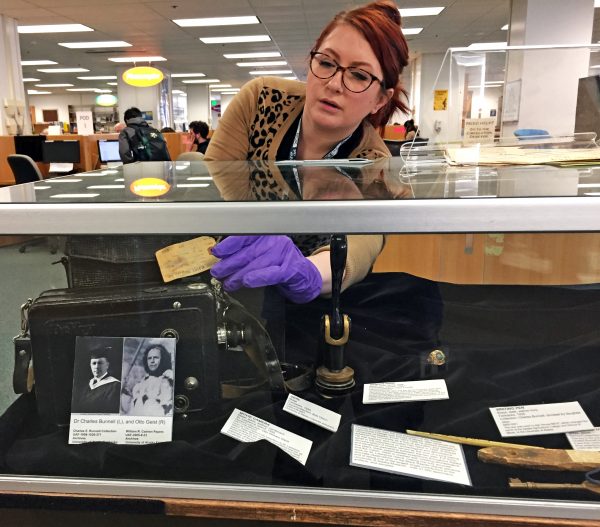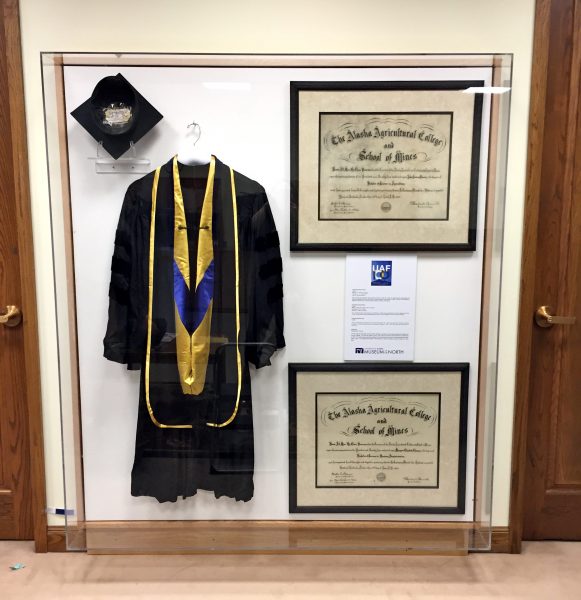Pop-up displays help connect UAF history through objects
May 2, 2017
Theresa Bakker
907-474-6941
Objects are a powerful way to connect with something intangible. Think of the Liberty
Bell or a dinosaur fossil. These symbols help bring abstract concepts alive, like
a historical event or a past that existed long before people walked the Earth.
University of Alaska Fairbanks student Kate Tallman spent this semester working to
excavate some of the university’s history for a centennial exhibit now on display
at the Rasmuson Library. She had plenty of resources, from documents archived at the
library to the history collection at the University of Alaska Museum of the North.
She just had to decide on a theme.

After some preliminary research, Tallman noticed that the first president of the university had a signature vision for the school.
“Charles Bunnell's vision was very community driven," she said. "I discovered that the university had been a key player in many significant events over its history, so that became my goal when looking for specific stories to feature in the display.”
Exhibits rely on objects to help tell stories. So Tallman pored through thousands of historical artifacts in the museum’s collections to find the best ones.
Once Tallman had a general idea of a story she wanted to feature, she searched the museum’s database for related artifacts. One of her favorites is a movie camera used by Otto Geist, a naturalist commissioned by Bunnell to collect archaeological, ethnological and paleontological specimens for the museum he envisioned as part of the new university’s mission.
Geist filmed the people of St. Lawrence Island during one of his most prolific expeditions. Some of those videos are now preserved at the university’s film archives.
Tallman was also excited to include several borrowed editions of the High Water News. Produced by the university during the 1967 flood, the title of the newspaper was updated as the water levels changed. During the flood, the Chena River covered downtown Fairbanks in a lake 5 miles wide. Thousands of people evacuated to the university, located on higher ground.
Tallman said finding objects that are historically relevant can be time consuming.
“That was the longest part of the process," she said. "You want to be absolutely sure that you are featuring artifacts that are not only interesting and applicable but are also the most historically accurate.”
Angela Linn, the museum’s senior collections manager of ethnology and history, has worked over the past 15 years with student employees and interns to install real museum exhibits. These pop-up displays at locations across campus highlight specific topics relating to the stories of Alaska's residents.

“Exhibits are the way most people interact with museum collections,” Linn said. “Unless you have a class or a research project that involves coming into the lower level of the museum, the majority of the university community experiences only a tiny percentage of those 1.5 million objects and specimens preserved at the museum.”
The university’s centennial legacy is also on display at another location on campus, a newly installed wall case in the chancellor’s suite. Linn is excited about the new case, which offers a large-format installation space that can be refreshed every few years.
The current exhibit showcases the legacy of graduation at UAF. It features home economics professor Lola Tilly’s cap, Geist’s gown and university regent Mike Walsh’s honorary doctoral hood. It also includes copies of two of the first diplomas awarded to graduates. The display was the result of a collaboration with Jeannie Phillips from the chancellor's office.
While some people might feel that history is just a monotonous string of names and dates, Tallman hopes exhibits like these can change minds. Her own interest flourished when she moved to Fairbanks with her husband to pursue a degree at UAF and discovered the museum research apprenticeship program.
“You get to learn from and gain work experience under industry professionals who have decades processing, cataloging, curating and preserving knowledge,” she said. “And Alaska is such a unique environment. The ethnology department works to preserve and protect the history and culture of people who live nowhere else on the planet.”
Linn said that has been a common experience.
“I have loved seeing the creativity and academic rigor students put into these exhibits over the years. I've never been disappointed," Linn said. "I think the most important thing that they learn is that exhibits don't ever just ‘pop up.’ They take a lot of effort and coordination.”
The centennial exhibit now on display in the Rasmuson Library is something the extended UAF community can connect with, though Tallman herself doesn’t have long years of experience here.
As it turns out, she was learning all about her new community as she worked on her project.
“It might sound cheesy, but I really grew to love this school as I learned about its history," she said. "I am so proud to say I will be an alumna of UAF.”


